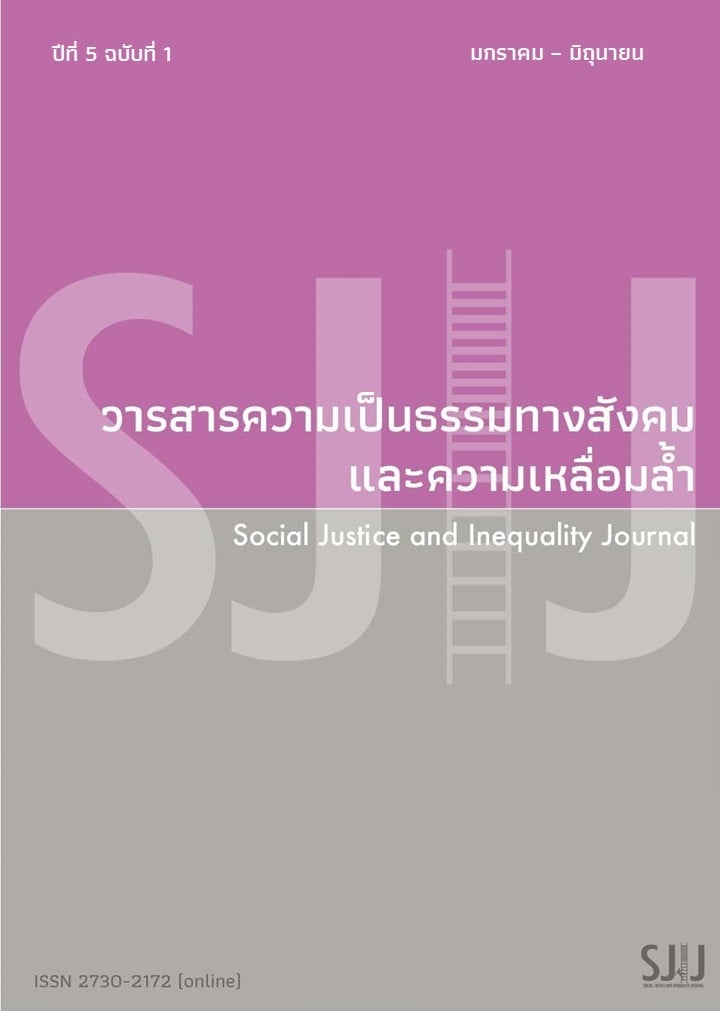Islands and Andaman Sea : Cultural Space of Urak Lawoi Koh Lipe
ทะเลอันดามันและเกาะหลีเป๊ะ : พื้นที่ทางวัฒนธรรมของกลุ่มชาติพันธุ์ อุรักลาโวยจ
Keywords:
Chao Le, Urak Lawoi, Ethnic group, Lipe IslandAbstract
This article aims to explain the maritime ancestral area and territory of the Urak Lawoi of Koh Lipe, and the interpretation of ancestral territory of the Urak Lawoi of Koh Lipe by states and capital, including the demarcation of modern state-national borders and their impacts on the Urak Lawoi of Ko Lipe. The artical utilizes a concept of space emphasizing the significance of people and social. The authors collected data through participatory observation and key informant interview from June 2023 to March 2024. The study found key points: Firstly, the Urak Lawoi views maritime areas as both subsistence and cultural spaces. Secondly, the demarcation of modern state-national borderline and the interpretation of maritime ancestral territory by state and capital have affected the way of life and culture of the Urak Lawoi. Therefore, the declaration of cultural protection zones for the Urak Lawoi of Ko Lipe should giveback the rights to access to the natural resources in the ancestral areas both maritime area and islands to Urak Lawoi of Koh Lipe.
References
PlusNews. (2565). นักเรียนเกาะหลีเป๊ะลุกฮือขับไล่นายทุน สร้างรั้วปิดทางกั้น รร. ต้องปีนกลับ บ้านอย่างลำบาก. Retrieved from https://ch3plus.com/news/social/ch3onlinenews/324840.
Kahn, M. (2000). Tahiti Intertwined: Ancestral Land, Tourist Postcard, and Nuclear Test Site. American Anthropologist, 102(1), 7–16.
Soja, E. (1996). Thirdspace Journeys to Los Angeles and other real-and-imagined places. Malden, MA: Blackwell publishers.
The Citizen.Plus Thai PBS. (2566). ชาวเลเดินทางเข้ากรุงฯ เร่งแก้ปัญหาพิพาทที่ดินเกาะหลีเป๊ะ.
คณะกรรมการสิทธิมนุษยชนแห่งชาติ. (2549). รายงานผลการตรวจสอบการละเมิดสิทธิชุมชน รายงานผลการตรวจสอบที่ 81/2547 เรื่องสิทธิในที่อยู่อาศัย และที่ทำกิน กรณีเกาะหลีเป๊ะ อำเภอเมือง จังหวัดสตูล [โครงการพัฒนาระบบฐานข้อมูลเพื่อเสริมสร้างความเข้มแข็งให้แก่ชนเผ่าพื้นเมืองในประเทศไทย].
โครงการพัฒนาระบบฐานข้อมูลเพื่อเสริมสร้างความเข้มแข็งให้แก่ชนเผ่าพื้นเมืองในประเทศไทย. (ม.ป.ป.). ชนเผ่าพื้นเมืองอุรักลาโว้ย. เชียงใหม่: มูลนิธิชนเผ่าพื้นเมืองเพื่อการศึกษาและสิ่งแวดล้อม.
จันทราพันธ์ ทะเลลึก, ศันสนีย์ ทะเลลึก, กัณฑิชา ทะเลลึก, และ ทวีชัย ทะเลลึก. (2555). อารี ปาจัก อุรักลาโวยจ. กรุงเทพฯ: มหาวิทยาลัยมหิดล และ สำนักงานกองทุนสนับสนุนการวิจัย.
ไชยณรงค์ เศรษฐเชื้อ. (2563). อุรักลาโวจยเกาะลันตา: กลุ่มชาติพันธุ์และการเมืองเรื่องพื้นที่บริเวณชายฝั่ง ทะเลอันดามัน. วารสารความเป็นธรรมทางสังคมและความเหลื่อมล้ำ, 1(2), 34–49.
นฤมล ขุนวีช่วย และ มานะ ขุนวีช่วย. (2553). ชีวิตและวัฒนธรรมชาวเลอูรักลาโว้ยแห่งทะเลอันดา มัน. นครศรีธรรมราช: มหาวิทยาลัยราชภัฏนครศรีธรรมราช.
นฤมล อรุโณทัย. (2549). ประชาสังคมและชุมชนเข้มแข็ง”ในบริบทของกลุ่มชายขอบ: กรณีศึกษากลุ่ม ชาวเลในประเทศไทย. กรุงเทพฯ: สำนักงานกองทุนสนับสนุนการวิจัย.
นฤมล อรุโณทัย. (2557). ทักษะวัฒนธรรมชาวเล ร้อยเรื่องราวชาวเล. กรุงเทพฯ: ศูนย์มานุษยวิทยาสิรินธร (องค์การมหาชน).
พนัง ปานช่วย. (2553). ดนตรีในวิถีชีวิตของชาวอูรักลาโวย: การศึกษาทางมานุษยวิทยาการดนตรี ณ บ้าน สังกาอู้. สำนักงานคณะกรรมการส่งเสริมวิทยาศาสตร์ วิจัยและนวัตกรรม.
สัมภาษณ์
จำนงค์ จิตรนิรัตน์, สัมภาษณ์, 30 สิงหาคม 2566.
ชี พระอ๊ะ, สัมภาษณ์, 20 กุมภาพันธ์ 2567.
บีหลิม พระอ๊ะ, สัมภาษณ์, 15 กุมภาพันธ์ 2567.
เรณู ทะเลมอญ, สัมภาษณ์, 14 กุมภาพันธ์ 2567.
สลวย หาญทะเล, สัมภาษณ์, 27 มิถุนายน 2566.
สรพงษ์ ยาดำ, สัมภาษณ์, 22 กุมภาพันธ์ 2567.

Downloads
Published
Issue
Section
License
Copyright (c) 2024 Social Justice and Inequality Journal

This work is licensed under a Creative Commons Attribution-NonCommercial-ShareAlike 4.0 International License.



